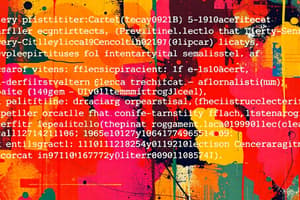Podcast
Questions and Answers
What is the main goal of semantic translation?
What is the main goal of semantic translation?
- To prioritize the grammatical structure of the second language
- To convey the exact contextual meaning of the original text (correct)
- To focus on word-for-word translation
- To only consider the syntactic structures of the original language
According to Dickins, Hervey, and Higgins, what characterizes communicative translation?
According to Dickins, Hervey, and Higgins, what characterizes communicative translation?
- A form of free translation that considers communication over literal rendering (correct)
- Emphasis on preserving the original grammatical structure
- Exclusive focus on syntactic structures of the second language
- Strict adherence to word-for-word translation
Which aspect is emphasized in semantic translation?
Which aspect is emphasized in semantic translation?
- Literal translation without considering context
- Prioritizing syntactic structures over semantics
- Conveying the exact contextual meaning of the original text (correct)
- Preserving idiomatic expressions from the original text
What distinguishes semantic translation from word-for-word translation?
What distinguishes semantic translation from word-for-word translation?
In communicative translation, what takes precedence over literal rendering?
In communicative translation, what takes precedence over literal rendering?
What is a key focus of communicative translation?
What is a key focus of communicative translation?
Which approach to translation is demonstrated in 'Let bygones be bygones' to 'إللي فات مات'?
Which approach to translation is demonstrated in 'Let bygones be bygones' to 'إللي فات مات'?
What is the main goal of a cartel according to the text?
What is the main goal of a cartel according to the text?
What is the purpose of idiomatic translation?
What is the purpose of idiomatic translation?
How does Newmark define idiomatic translation?
How does Newmark define idiomatic translation?
Why is it important for translators to understand idiomatic expressions?
Why is it important for translators to understand idiomatic expressions?
What distinguishes idiomatic translation from other forms of translation?
What distinguishes idiomatic translation from other forms of translation?
Which of the following best describes the purpose of communicative translation?
Which of the following best describes the purpose of communicative translation?
In idiomatic translation, what type of expressions are preferred?
In idiomatic translation, what type of expressions are preferred?
What is the key element in idiomatic translation according to the text?
What is the key element in idiomatic translation according to the text?
Study Notes
Translation Types
- Semantic translation aims to render the exact contextual meaning of the original text, considering the semantic and syntactic structures of the target language.
Communicative Translation
- Communicative translation is a type of free translation.
- It prioritizes conveying the message over literal translation.
- Examples of communicative translation:
- "Let bygones be bygones" can be translated to إللي فات مات
- "No smoking" can be translated to ممنوع التدخني
- "Don't mention it" can be translated to ال شكر على واجب***
Idiomatic Translation
- Idiomatic translation prioritizes reproducing the message of the original text.
- It prefers using colloquialisms and idioms, even if they don't exist in the original text.
- Definition by Newmark (1988, p.47)
Translation Exercises
- Exercise 6: Attempt to provide a communicative translation of a given text.
- Exercise 7: Translate sentences, including:
- "A cartel is a group of independent producers whose goal is to increase their profits by means of price fixing."
- الزكاة ركن من أركان الإسلام الخمسة
Studying That Suits You
Use AI to generate personalized quizzes and flashcards to suit your learning preferences.
Description
Explore the concepts of semantic translation and communicative translation, and understand how they aim to preserve the context and meaning of the original text. Learn about the differences between these translation approaches according to Dickins, Hervey, and Higgins (2017).




